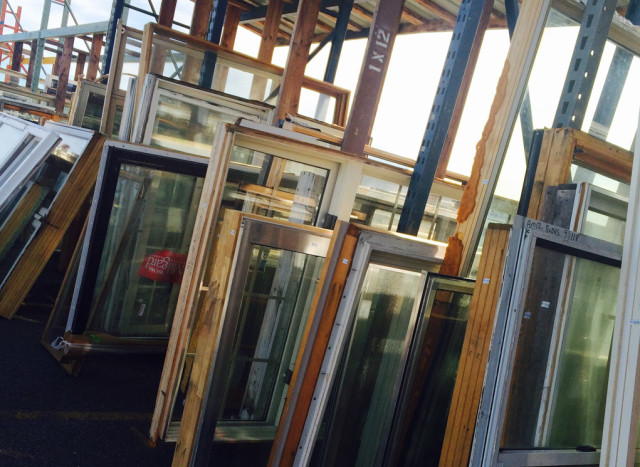
What does 3.8 million pounds look like? It could look like three Antonov An-225 airplanes, the heaviest planes ever made; or like a massive herd of fully-grown male African elephants, about 293 of them in all.
Here’s perhaps a better analogy: 3.8 million pounds is about the weight of six two-story, 2,500-square-foot (that’s “average-sized” in the U.S.) houses. It’s also the total weight of all the homebuilding materials ReSource kept out of the landfill in 2015, setting a new record for waste diversion through its materials resale center in Boulder. That’s a major accomplishment for ReSource, double the total weight of its diverted waste in 2006 and a 350,000 pound increase over 2014. And it’s a milestone for the City of Boulder as well, where about 36 percent of all landfilled waste is construction material.
The landfill’s hypothetical six-house loss was ReSource’s customers’ gain: whether homeowners making improvements, entrepreneurs furnishing new businesses, backyard farmers constructing raised beds and chicken coops or minimalists building tiny homes, they gave millions of pounds of materials sold at ReSource new life.
“We make it easy to conserve,” says Neal Lurie, president of the Center for ReSource Conservation, the nonprofit that operates ReSource. “People don’t necessarily have to think, ‘I’m saving a resource.’ They think, ‘I’m getting a high-quality material for a great price.’”
A large percentage of that material comes to ReSource through deconstruction projects. Under the City of Boulder’s Zero Waste Initiative and Green Points program, anyone demolishing a home must commit to keeping at least 65 percent of the total weight of structural waste out of the landfill. Contractors and homeowners can call on ReSource to assess the reusability of the materials in a home on the chopping block, and to then haul the materials to its resale facility, all for free. This saves time and money, complies with regulations and keeps waste out of the landfill and homeowners can claim the tax deductible donation.
In 2015, “deconstruction services” were ReSource’s fastest growing source of donated materials — about 35 percent of total donations. And even though ReSource sells its reclaimed materials at up to 75 percent less than retail value, it still makes business sense for the organization to use its staff and time to offer the free service.
At least, most of the time.
“If we get a phone call from Estes Park from someone who says they have one door to haul away, well, that might not be feasible,” says Brandon Hill, senior manager at ReSource. On the positive side, he says, more and more folks are in fact coming from beyond the Boulder city limits to both donate to and purchase from ReSource. Wherever they’re from, they’re showing that whether for economics, aesthetics or otherwise, reuse is going mainstream.
Andy Clark, owner of the new Moxie Bread Company in Louisville, was a regular customer while he built his bakery’s interior, selecting materials to evoke just the right rustic look and farmhouse feel. Boulder artist Mitch Levin frequents ReSource to find unique salvageable metal and materials for his renowned sculptures and other artwork. Adriana Galue Manrique, local EMT and true do-it-yourselfer, turned a gutted 300-square-foot space into a fully functioning tiny home in Ward, spending just $34 per square foot and using only repurposed materials.
“We have a guy who comes up sometimes from Chihuahua, Mexico to buy materials for his project,” Hill says. “It’s worth it for him to make that drive with a trailer.” Hill himself finished his entire apartment with ReSource materials, he says, for just a few hundred dollars. And if customers don’t have the tools they need to complete their project, they can rent from among the more than 700 tools in ReSource’s tool library for just a few dollars a day (but they probably shouldn’t take them all the way to Chihuahua).
Of course, not everything can be “ReSourced” easily. “Windows are tricky,” Hill says; unlike doors, built to standard sizes, windows come in all dimensions and not always the ones people are looking for. On the intake side, ReSource won’t accept things like older plumbing fixtures that may contain lead or old appliances that are energy hogs. “We’d rather scrap those and take them off the streets,” Hill says; ReSource endeavors to exhaust the non-landfill options for all the materials it can’t process, appliances and otherwise, before throwing them away.
Lumber will be one of ReSource’s major challenges in 2016.
“We currently have more lumber than we could possibly process,” Lurie says, even with 16 full-time employees plus a fleet of volunteers and community service crews. That’s why the organization is piloting a new “denailing program” to efficiently remove the countless nails lodged in donated lumber, rendering more of the reclaimed wood usable, more quickly.
As with so many things Boulder, it’s hard to say whether ReSource would flourish in another city — one without the unique mix of creative juices, conservation priorities, Western go-getterism and housing pressures. But no matter, Hill says: “Boulder is really the perfect place for us.”














